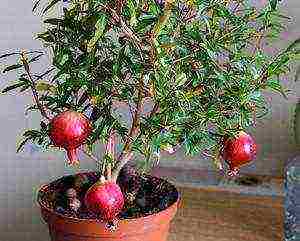Content [show]
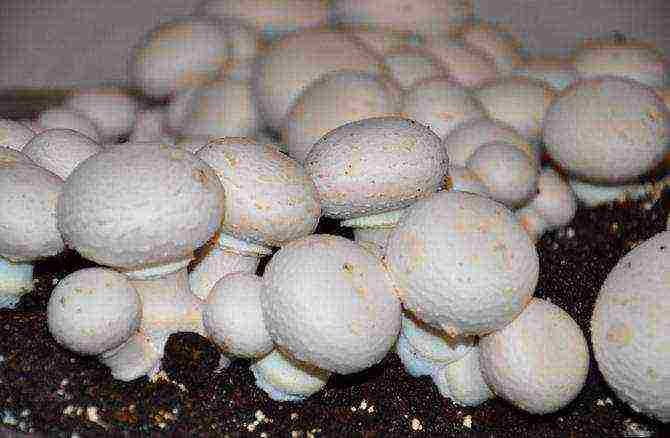
Champignons today have become the kind of mushroom that is available for growing at home. The time between planting the mycelium in the substrate and obtaining the first fruits is minimal. No special conditions are required for mushroom cultivation. It is enough just to provide a cool room with high air humidity. A basement or cellar is fine.
Champignons can be grown both for personal use and for sale. But it is important to know that the substrate for their growth when wet exudes a rather strong odor. It is not advisable to keep it in a residential area.
Where and on what do mushrooms grow?
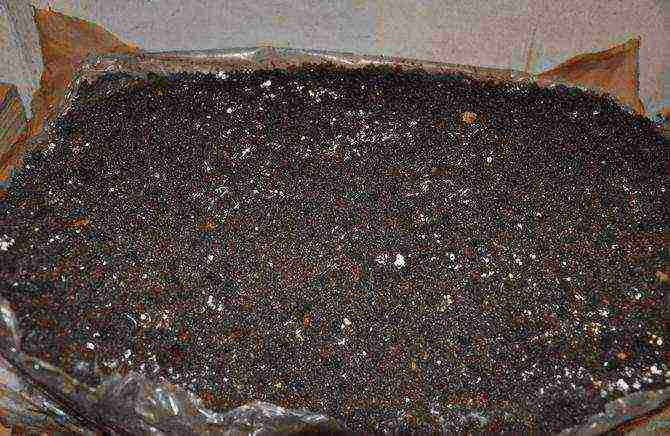
The very first and most important step in the successful cultivation of mushrooms is the correct preparation of the substrate. It must be prepared with high quality in compliance with all stages.
The mushroom substrate consists of:
- 25% compost (wheat and rye straw)
- 75% horse manure
There is experience in growing champignons based on chicken manure or cow dung, but you should not expect a high yield in this case.
The substrate is prepared in an open space on the street or in a well-ventilated room, since ammonia, carbon dioxide and moisture will be released during its fermentation. Additional additives per 100 kg of substrate are:
- 2 kg of urea
- 2 kg superphosphate
- 5 kg of chalk
- 8 kg of plaster
As a result, we get almost 300 kg of the finished substrate. With such a mass, you can fill a mycelium with an area of 3 square meters. m.
If a decision is made to prepare compost based on chicken manure, then the proportions will be as follows:
- 100 kg of straw
- 100 kg of litter
- 300 l of water
- Gypsum
- Alabaster
The procedure for preparing the substrate is as follows.
- Straw is soaked in a large, spacious container.
- The straw is laid in alternating layers with manure. There should be 3 layers of straw and 3 layers of manure.
- Straw in the process of laying in layers is moistened with water. Three layers of straw (100 kg) will take about 300 liters.
- During the laying of the layers, urea (2 kg) and superphosphate (0.5 kg) are gradually added in small portions.
- Mix thoroughly.
- Add chalk and the remainder of superphosphate, gypsum.
The resulting substrate is left to undergo a decay process. In this case, the temperature in the mixture will rise to 70 degrees. After 21 days, the compost will be completely ready for further use.
Planting material
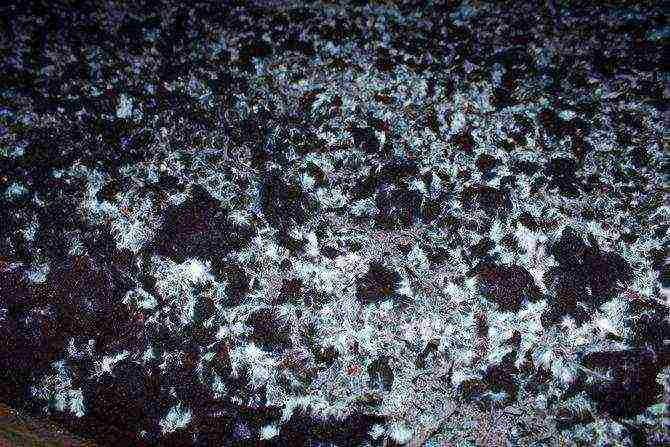
When purchasing planting material, you should not save. Therefore, they acquire only the highest quality mycelium (mycelium). It must be grown under special laboratory conditions. Today mycelium producers present two types of planting material:
- Compost mycelium
- Grain mycelium
Grain mycelium is produced in plastic bags. Store it for about 6 months at a temperature of 0 to 4 degrees.Grain mycelium is used at the rate of 0.4 kg per 100 kg of substrate (mycelium area is 1 sq. M).
Compost mycelium is sold in glass containers. Its shelf life depends on the temperature. At zero degrees, it can last for about a year, but if the temperature is at 20 degrees, then the mycelium must be used within 3 weeks. Compost mycelium is used at the rate of 0.5 kg per 1 square meter of substrate. Its yield is much lower than that of grain.
A properly prepared substrate will surely spring when pressed. Before placing the mycelium into it, it must undergo a pasteurization (heat treatment) process. After heating, the substrate cools down to 25 degrees. A mycelium of 1 square meter is laid with about 100 kg of substrate with a layer of about 30 cm.
Planting mycelium and caring for mycelium
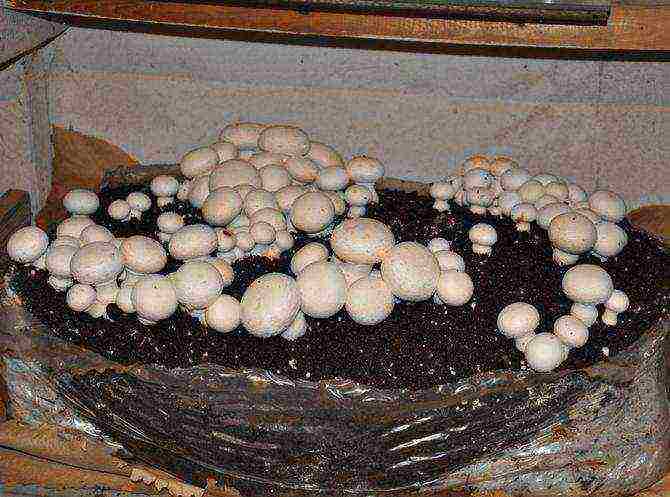
They take a piece of mycelium the size of a chicken egg and put it into the substrate about 5 cm. Each portion of mycelium is placed at a distance of 20 cm from each other. A staggered arrangement is used for landing.
Another method involves uniform distribution (dusting) of the entire surface of the substrate with mycelium. You also need to deepen by no more than 5 cm.
Further actions are to provide the necessary conditions for the engraftment and germination of the mycelium. Air humidity should be kept at around 90%. The substrate must also be kept moist at all times. To prevent it from drying out, the myceliums can be covered with sheets of paper. Watering the substrate is carried out through the paper. An important condition for mycelium engraftment is a constantly maintained substrate temperature at a level of 22 to 27 degrees. Any temperature deviations from the norm must be corrected immediately.
The germination time of the mycelium is approximately 7 to 14 days. After this period, the substrate needs to be sprinkled with a casing layer of soil about 3 cm. It is prepared independently from one part of sand and nine parts of peat. About 50 kg of casing layer will be consumed per square meter of mycelium.
The covering layer is kept on the substrate for three days, then the air temperature in the basement or cellar is reduced to 15-17 degrees. The cover soil is moistened with a spray bottle, and the room is constantly ventilated. Drafts are not allowed.
Harvesting
The process of self-cultivation of champignons in a cellar or basement is not too complicated and time-consuming. The period from planting to harvesting the first crop is 120 days. Only those mushrooms in which the plates under the cap are not yet visible are suitable for eating. Those mushrooms that are large are overripe, and dark brown plastics are forbidden to be used for food. They can cause poisoning.
The mushroom must not be cut, but carefully plucked with a twisting motion. The resulting depression is sprinkled with a covering substrate and moistened.
The mycelium will bear fruit for about 2 weeks. The number of crops harvested during this period is 7. Up to 14 kg of crop is harvested from one square of the area.
Growing mushrooms in bags

For growing champignons in large volumes for sale through retail chains I use polymer bags. This method has received its recognition in many countries. With its help, a large harvest is obtained.
- For the manufacture of the bag, a polymer film is used. The capacity of each bag varies from 25 to 35 kg.
- The bags should be of just such a volume so that it is convenient to work with them. In addition, the correct arrangement of the bags affects the number of mushrooms grown. They are usually staggered or parallel.
- So when installing bags with a diameter of about 0.4 m in a staggered arrangement, only 10% of the usable area will be lost, while their arbitrary installation gives losses of up to 20%.
- The height and width of the bags may vary. You need to proceed from their conditions and convenience of work, as well as the physical capabilities of the basement (cellar).
The method of growing mushrooms in bags is less costly, since they do not require specially mounted shelves or containers to place them. If it becomes necessary to use the area of the room as efficiently as possible, then a multi-tiered system can be created for the location of the bags. The advantage of this method also lies in the speed of dealing with emerging diseases or pests. The infected bag can be easily removed from healthy neighbors and destroyed, while if the mycelium is infected, it will have to remove its entire area entirely.
It is important to remember that growing mushrooms is a rather laborious process. If champignons are grown for sale, then it is impossible to do without the use of agricultural equipment to facilitate the work of the workers.
Experienced mushroom pickers can list a large number of methods they have tested for growing mushrooms on their own in a basement (cellar). Each method has its own advantages and disadvantages. The main thing is adherence to the cultivation technology, strict adherence to all instructions and requirements. The result is the achievement of the desired result and obtaining a rich harvest of mushrooms.
How to grow champignons at home (at home)
Champignons are quite common mushrooms. They are massively grown for use in the food industry, in particular in cooking. Entrepreneurs build their business on their breeding, which brings good income. But experienced farmers prefer home-grown mushrooms. Read about this in the article.
What is included in the soil?
Is it possible to grow champignons at home? Of course, this is within the power of a farmer or owner of a private backyard without any experience. The main thing is to stock up on knowledge in this matter and clearly follow the instructions. The most time consuming process in mushroom cultivation is soil preparation. For a mycelium area of three square meters, 100 kilograms of plant ingredients will be required, which include the following:
- Straw.
- Cereal grains, you can use rye or wheat.
- Fallen leaves of plants.
- Tops from tomatoes or potatoes.
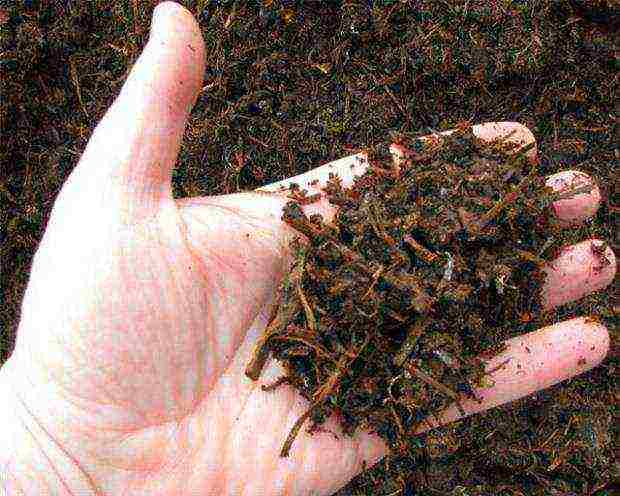
In addition, the composition of the soil should include:
- Horse or cow manure in the amount of half a centner.
- Water - 300-400 liters.
- Urea and superphosphate in an amount of two kilograms each.
- Plaster - seven to eight, and chalk - five kilograms.
You can prepare a different formulation using poultry droppings. Other ingredients and their quantity are taken here:
- Litter and straw - centered.
- Water - 300 liters.
- Gypsum, alabaster - as in the previous composition.
- Urea is two kilograms.
Composting process
First you need to make a collar with the same dimensions (one and a half meters) in width, length and height. It is with this ratio of parameters that combustion will properly occur. The compost will mature in two to three weeks.
How to grow mushrooms at home? First, you need to plant them in soil, which is prepared as follows: all components of plant origin and straw must be soaked for a day. At the same time, they and manure should be laid in layers, and the straw should be watered abundantly. The components contained in the pile must be thoroughly mixed and moistened once a week to ensure proper combustion. At the first mixing, crushed lime is added to the compost. Second time - superphosphate. Then mixing is carried out with the addition of crushed gypsum or alabaster. Each time after mixing, the resulting stack is covered with foil.
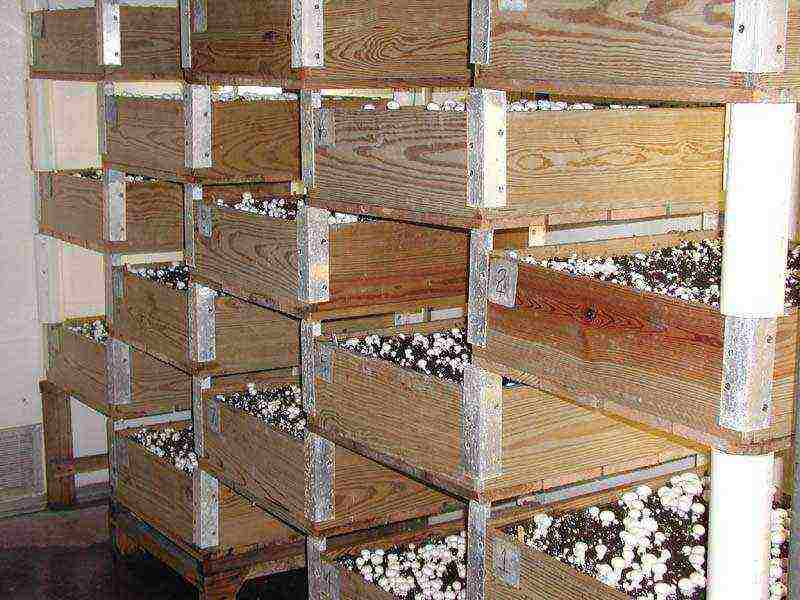
It should be borne in mind that during the preparation of the soil, an unpleasant odor will be emitted, similar to ammonia and carbon dioxide. Therefore, it is better to do cooking on the street. But at the same time, protection from sunlight and precipitation is needed. If you organize the process indoors, it should be well ventilated.
How to grow champignon mushrooms at home? To do this, you need to take into account important points, without which this process is impracticable.First of all, a stock of compost is made, since it is necessary in a large volume to grow mushrooms. During its preparation, the temperature can reach from 53 to 70 ° C. When the combustion process is over, the thermometer will drop to 21-25 ° C, and the unpleasant odor will disappear. The finished soil has an elastic structure and a brown color. It does not stick to your hands, the straw can be easily torn apart.
How to properly lay out the compost?
When the preparation of the soil is completed, they proceed to another procedure - laying it. First, you need to select the containers in which the mushrooms will be grown. They can be racks, wooden boxes, plastic containers, bags. The compost mass is laid out in prepared containers in a layer, the height of which should not exceed 22 cm.
Mycelium types
The seed of mushrooms is called mycelium. It is grown at home or in laboratories. There are two types of mycelium:
- Compostable - this type of seed is stored for a long time at zero temperature, for about a year. For an area of one square meter, 500 g of mycelium will be required.
- Grain - this composition is more effective than the first. Seed material of this type germinates better and gives large yields. Its consumption for the same area is less, only 330-350 g. But this mycelium has a significant drawback: a short shelf life. Its properties are preserved only for half a year. Keep the seed in the refrigerator.
How to grow mushroom mycelium at home?
If the mushrooms are grown commercially, it is better to buy planting material. But some are embarrassed by the conditions in which it was grown, and therefore they do it on their own. To obtain the material, you need to sow spores or isolate it from the fruit bodies, and then place it in a specially prepared medium: wort agar. Its preparation is carried out according to the following technology:

- First you need to mix beer wort (one liter) and agar-agar (20 g) with boiling water.
- After dissolving the ingredients, the composition is poured into test tubes for a third of them. Then the containers are plugged with cotton swabs and placed in an autoclave with a temperature of 101 ° C and 1.5 atmospheres for 30 minutes.
- The test tubes are placed not straight, but obliquely, so that no more than 3.5 cm remains to the plugs. Now it remains to wait until the wort hardens.
- After that, spores or a piece of the fruiting body must be added to the test tubes, while observing sterility.
- Containers should be kept in a thermostat or dark room at a temperature of 24 ° C until they are overgrown. In a couple of weeks, the nutrient medium will be assimilated by the myceliums. This means that they are completely ready for landing.
Usually this composition is used by mushroom pickers to grow mycelium at home, although there are also substitutes: oat agar, carrot agar.
Correct mushroom cultivation technology
Mushrooms can be grown at home using mycelium. To do this, you need to plant it correctly, and in the room you need to correctly select the temperature and humidity mode. If these conditions are met, the first harvest can be obtained in a year.
If grain mycelium is the planting material, grooves 30 cm deep and 50-60 cm wide should be made in the soil. The distance between the pits should be 20 cm. In order for the temperature to normalize, you need to leave them for two to three days and only then lay the mycelium. A checkerboard pattern is used to locate the body of the mushroom.
If compost mycelium is used for planting champignons, the technology is different. The bottom of the small pits is covered with drainage. Compost is placed on top, in which the mycelium is placed. After that, the planting material is closed by it. Subject to all the rules, taking into account the high-quality mycelium, after seven days, you can expect the appearance of new branching threads.
After 21 days, you need to lay out moist soil on top of the beds 25-30 cm thick. If the layer is larger, the bodies of the mushrooms will be blocked, their germination will not occur soon.
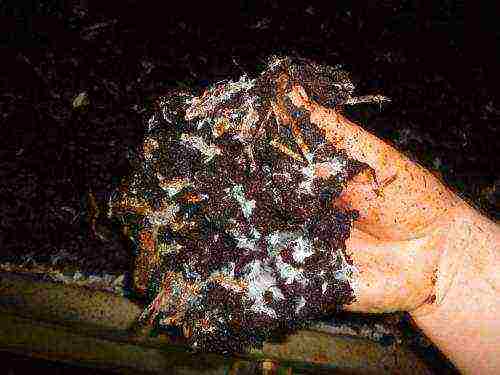
In order to maintain the temperature regime in the room where the mushrooms are grown, you need to temporarily install sheds or cover the ground with straw. If a white bloom appears on the compost, it means that it needs to be moistened. After watering the soil, the canopy or straw is removed.
The first harvest will not take long, only 45 days. You need to pick mushrooms as soon as they ripen, since the yield period is short, only three to four days. The next fruiting period should be expected in three to four months. The harvests of the first waves are the richest.
Champignons in bags
How to grow champignon mushrooms at home? There are many possibilities for this. Each courtyard has outbuildings and basements. They are adapted for growing mushrooms. However, you can grow mushrooms at home in plastic bags. This method has been used in many countries for a long time. It allows you to get large volumes of mushroom harvest.
Bags can be made by yourself from a transparent polymer film of various capacities. For growing at home, 25 kg are more suitable. But the main criterion for choosing bags is the convenience in performing work on growing mushrooms. And for it to be successful, you need to correctly arrange the bags in the room. This is done in a variety of ways, but the most common are the following:

- According to the principle of chess arrangement. With this method, the usable area is not used only by 10%.
- Parallel bag placement. In this case, the area loss is even greater - 20%.
This can be compensated for by deep bags, which are filled with more substrate. And the space between the unusual beds is used for air circulation. There are different options for how to grow mushrooms at home. If everything is done in compliance with the technology, you can achieve an excellent result.
Harvest in bags
The mushroom picking time is the most enjoyable time. The mushrooms ripen four months after planting the mycelium in the soil of the bag. When harvesting, you need to be very careful: you cannot cut off the mushrooms with a sharp blade or other object, they need to be twisted. After that, the mycelium is sprinkled with a nutritious substrate and watered using a spray bottle. It will bear fruit for two weeks. During this period of time, the mushrooms are harvested in two to three days. It is advisable to use fresh, not frozen mushrooms for food. Mushrooms with light plates inside the cap are useful. If the mushrooms are old, they will have a brown color, as these mushrooms accumulate toxic substances that can be poisoned.
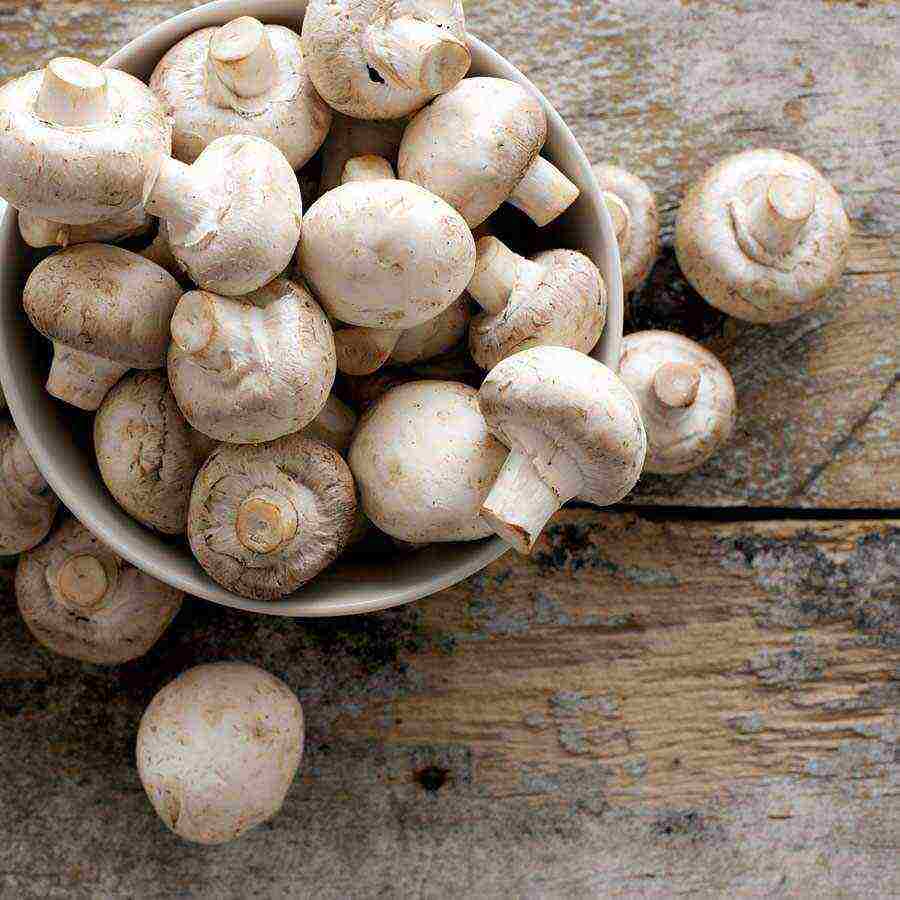
Benefits of growing mushrooms in bags
These mushrooms are unpretentious, they can grow in an open-air garden bed or indoors. But experienced mushroom pickers prefer to grow them in bags, since this method has a number of advantages:
- Pests and various diseases do not spread to the entire area, since if the need arises, you can always remove a specific bag from the room.
- Thanks to the mobility of the unusual bag-shaped beds, mushrooms can be grown seasonally and continuously.
- During placement, bags can be placed in several tiers on special stands. This will save space. This is especially important when growing indoors.
- The cost of polyethylene bags is lower than plastic containers. This is important when growing mushrooms in large quantities.
The disadvantage of this technology is the use of manual labor. But if the scale of cultivation is small, it is not burdensome.
Champignons in the basement
It is convenient to grow mushrooms in such a place, since there is a stable microclimate in the basement located under the ground. Here, the labor costs for creating optimal conditions for cultivating champignons are much less than, for example, in greenhouses. It is not difficult to grow mushrooms at home in the basement, the main thing is to monitor the temperature and humidity conditions.During the incubation period, the air humidity should be 75%, not lower. If the basement is dry, use a humidifier. It is important to know that spores are activated at a higher temperature - from 24 to 28 ° C, and fungi germinate when it drops to 16 ° C. The basement must meet the following requirements:
- Have concrete walls.
- Wooden flooring is strictly prohibited. The floor needs to be concreted, in extreme cases - to cement it.
- There must be ventilation in the basement.
- To prevent fungi from damaging insects that can enter the basement, the ventilation holes are closed with nets.
- Walls with ceilings should be disinfected. For this, you can use lime.
- If the basement is large, it must be divided into zones: for the incubation period and for obtaining fruit bodies.
How to properly grow mushrooms at home in the country?
Growing mushrooms in this way is much more difficult than, for example, in a basement. Here, the choice of a site for planting mycelium is of great importance. How to grow mushrooms at home? To do this, you need to find a place that is always in the shade, and the soil never dries up. A canopy is erected over the site or a darkened greenhouse is erected at this place. How mushrooms are grown at home (photos are presented in the article)? The mycelium is planted using standard technology. For champignons, an important condition for growth is the correct temperature and humidity. These indicators should be maintained, especially since the mushrooms categorically do not tolerate heat. The choice of substrate is equally important. It should contain large amounts of nutrients and small amounts of carbon dioxide. The best option is land, which must be brought from the forest in advance.
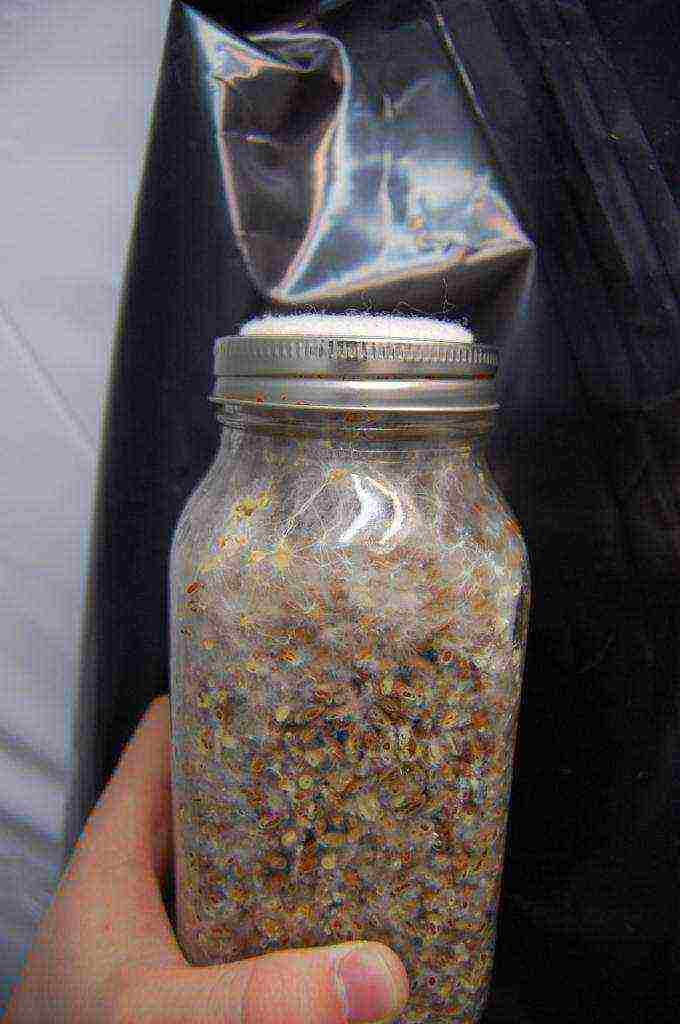
Growing champignons in an apartment
This method is suitable for those who do not have a summer cottage or vegetable garden. The main task for such cultivation of mushrooms is to create optimal conditions under which they will grow and bear fruit normally. An example of how to grow champignons at home is presented step by step below:
- The first thing to do is to isolate any room in the apartment for growing mushrooms from those rooms in which people live.
- Measure moisture. It should be high, about 90%. If its readings are lower, you need to install a humidifier.
- To maintain the optimum temperature, the room is equipped with heaters and ventilation. With their help, the temperature regime will be maintained. It should be borne in mind that mycelium germinates at 20 ° C, and fruiting bodies - at 15 ° C.
- After preparing the room, the selected containers are filled with the substrate.
- Mycelium is planted in them, covered with a film on top, which must be removed after the appearance of the fungi.
- The soil is constantly moistened, it must not be allowed to dry out.
- When the time comes, the mushrooms should be harvested.
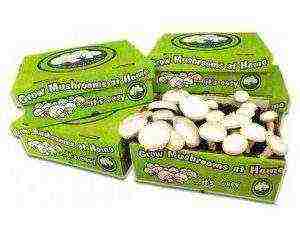
Even a novice mushroom picker can grow champignons, it is enough just to find out what conditions it is important to create for the cultivation of such mushrooms.
Breeding
You can breed champignons in different ways, but taking into account the following features:
- The mycelium should be added to the substrate at a compost temperature of about + 25 + 27 degrees.
- For the incubation period, the temperature is maintained at a level of 22 to 25 degrees Celsius, and for the period of appearance of mushrooms, a temperature of 14 to 17 degrees is needed.
- Ventilation during the incubation period is not needed, but during fruiting, it is very important to ventilate the room, since the champignon is quite sensitive to excess carbon dioxide.
- Champignons do not need lighting.
- The collection of champignons is carried out by extracting the mushrooms together with the root. Unscrew the mushroom and carefully separate it from the soil. Such collection will not cause mycelium depletion.
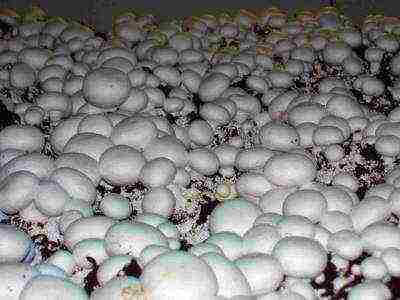
Tools and materials you will need:
- Storage containers
- Shovel
- Polyethylene film
- Sprayer
- Scissors
- Boot
- Irrigation hose
- Urea
- Compost
- Superphosphate
Mycelium
Most often, mycelium is purchased from trusted suppliers. It can be compost (more resistant to external factors) and grain (better quality). From companies selling mycelium, you can also purchase ready-made myceliums.
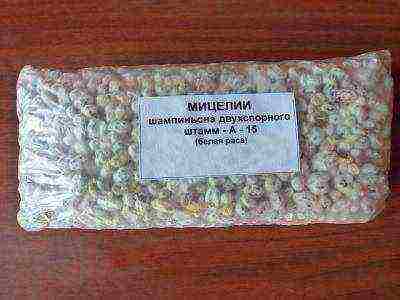
You can prepare raw materials for planting champignons yourself from overripe mushrooms. They are poured with water and left for a day so that the spores get into the liquid. Such a liquid is evenly watered over the soil and sprinkled with a 1-centimeter layer of earth.
You can also use wild-growing mycelium for sowing, taking it in places where mushrooms grow in nature. The mycelium is mined in September - after removing 1-2 centimeters of soil, they take out pieces of soil (a square with a side of 10-30 cm) with the mycelium threads, dry them a little and send them to storage in a cool room until spring. In the spring, it can be planted at a summer cottage. Also, this mycelium can be propagated in a greenhouse or basement.
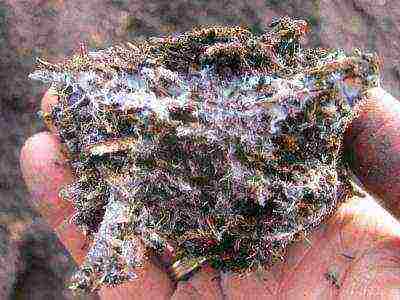 In the beds
In the beds
The most inexpensive and simple method of planting champignons, suitable for many mushroom pickers, is growing in ordinary horizontal beds, which are soil with fertilizers. Such beds are arranged in greenhouses, basements, shallow mines, old vegetable stores and similar premises.
An important condition for such premises is high humidity, and the temperature regime is considered a minor factor that can be influenced by the use of heaters.
The method is considered to be quite profitable, therefore it is in demand among most farmers.
Its advantages:
- No need to buy trays.
- The beds are done very quickly.
- The usable area is used rationally.
But there are also quite a few disadvantages:
- There is a high probability of infection (the premises cannot be cleaned, therefore infections are often brought from the street and on clothes) and its rapid spread throughout the garden.
- The bed is at an uncomfortable height.
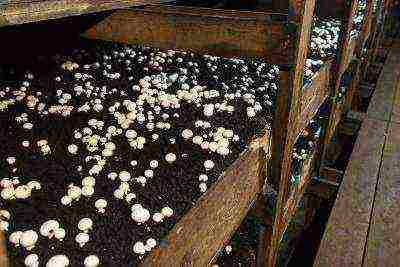
Stages of growing mushrooms in the beds:
- Composting. Lay a plastic wrap on a flat floor to retain moisture. Compost is poured onto this film, creating a layer about 30-40 cm thick.
- Sowing mycelium. Furrows are made in the compost and sown with the acquired mycelium. You can also simply sprinkle the mycelium evenly on top, covering it with compost (about five centimeters).
- Watering. After sowing, the compost should be watered regularly and abundantly. Only with a sufficient amount of moisture will you get good mycelium growth.
- Collection. The fruiting bodies of the mushrooms, ready for harvest, appear in ten to twelve weeks.
At home
A more modern method of mushroom breeding is the shelf system, which is also called the Dutch method. It is based on the use of shelves and drawers. With the rational use of the area with such a system, high-quality care is carried out.
The main disadvantage of growing on shelves is the need to use rather expensive equipment. Such cultivation of mushrooms will be profitable only when using good varieties with abundant frequent harvests. And it is precisely such a high yield that makes the method quite profitable, because the labor costs for such cultivation will be two to three times less than when using horizontal rows.
The substrate is placed in plastic containers, which are laid out in rows. Also, the technique provides for drip irrigation, preventing infections from entering the lower containers from the upper rows.
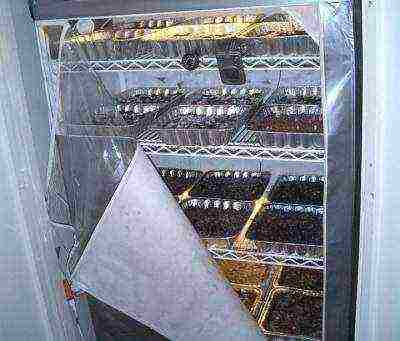 In the basement
In the basement
It is very convenient to grow mushrooms in basements, because underground rooms have a relatively stable microclimate. In addition, it is much easier to create optimal conditions in basements than in greenhouses.
You can even grow mushrooms in an ordinary basement. It is desirable that such a basement contains:
- concrete walls;
- concrete or cemented floor;
- good ventilation.
To prevent infection of fungi by pests, ventilation openings are recommended to be covered with nets, and the ceiling and walls should be treated with lime. If the basement is spacious enough, it can be divided into two zones - one will undergo the incubation period of growing, and the second will receive fruiting bodies. To maintain high humidity (85-90%), the basement floor is moistened.
 In bags
In bags
Another technique for growing champignon in the basement is the technology by which oyster mushrooms have been grown for a long time. It consists in using plastic bags. This method is practical and gives a good harvest, but it does not require significant material investments.
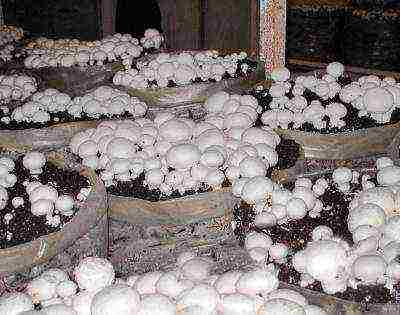
Stages of growing mushroom in bags:
- Substrate preparation. To obtain an excellent raw material for growing mushrooms, mix horse manure (15 kg), black soil (5-6 kg), straw (3 kg), mullein and sunflower husk (2 kg each). By filling this mixture with water, you will see that it heats up to a high temperature and burns out. Leave it on for 20 days, then spread it out in a thin layer to dry.
- Sowing mushrooms. After filling the bags with the substrate to the top and filling them with water from above, then you need to make holes in the polyethylene with a diameter of about ten centimeters. In order not to break the bag, such holes are made in a checkerboard pattern. A mycelium is placed in each cell.
With this technology, you save on containers, but at the same time you get all the advantages of growing mushrooms on the shelves.
If the infection enters one bag, it must be disinfected or simply thrown away and the bacteria will not enter the neighboring bags.
The disadvantages include the rather laborious first stage of cultivation, because a lot of manual labor is needed to prepare the substrate, fill bags, moisten and other work.
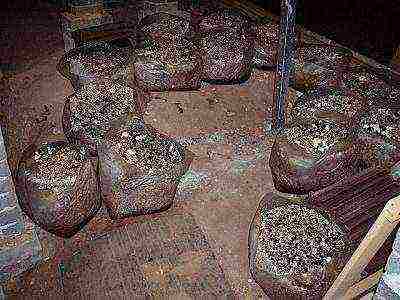
You can also grow mushrooms in briquettes. They are compressed blocks, based on manure, sawdust, husk, peat and other components in the right proportions, placed in polyethylene.
The undoubted advantage of this method is the absence of the need to waste time and energy. The farmer receives the finished material in the form of rectangular or cylindrical briquettes. They can be placed in containers or hung from ropes.
Having collected 3-4 harvests, the blocks are replaced with new ones. The yield of this technique is quite high and stable.
The disadvantages include only the cost of the briquettes themselves.
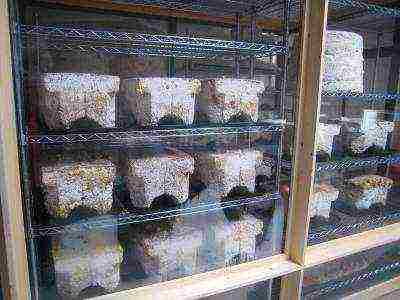 In the country
In the country
You can breed champignon in the country in different places: in greenhouses, in the basement, and even just in the beds in open ground. The location is not so important, it is much more important to achieve the conditions necessary for the appearance of mushrooms - a certain temperature regime, sufficient humidity, access to air and the absence of direct sunlight.
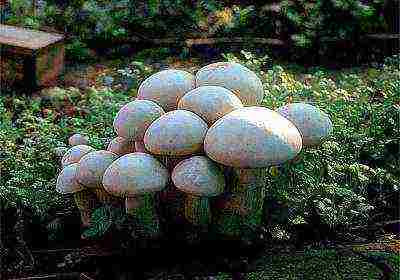 In the garden and in the garden
In the garden and in the garden
In order to grow mushrooms in your garden, it is important to find a shaded place for them, in which nothing is grown.
A good place would be the north side of the site, for example, behind a house, where there is little sun and the humidity lasts longer. The beds are covered with a canopy, which serves as protection from rain and sun. With this cultivation, the ventilation of the mushrooms will be natural, so the mycelium in the ground will not rot.
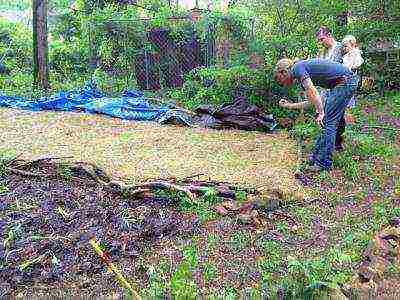
Significant spending on growing mushrooms in the garden is not required. It is only important to properly prepare the compost, the basis of which will be manure (chicken or horse). Urea and hot water are added to the manure, after ten days it is shaken up, mixed with chalk and compacted a little. Another ten days after adding superphosphate, the manure is well compacted and waiting for ripening (it should become light brown and crumbly).
A layer of manure 35 cm thick is laid on the prepared bed, dividing it into sections (squares with a side of 20 cm). The mycelium is planted at an air temperature of about +20 degrees to a depth of about 5 cm, after which it is sprinkled with compost a little, watered with water and covered with newspaper or plastic.
When the mycelium appears (after about 20 days), the shelter is removed and a 3-centimeter layer of turf and peat is poured onto the garden bed.Expect the first mushrooms in 25 days. Collect them on time and water the beds with warm water twice a week.
In the greenhouse
Champignons belong to unpretentious mushrooms, which have a fairly high growth rate. These parameters allow them to be grown in greenhouses. Up to 30 kilograms of mushrooms can be harvested from one square meter in a greenhouse at a time.
In a greenhouse, 3-7 harvests can be obtained per year. With this method of growing mushrooms, it is important to control humidity and temperature, use a good substrate, and ensure that excess carbon dioxide is removed.
In order for the mycelium to sprout quickly, after sowing, the soil is covered with polyethylene.
You need to water the crops before the first shoots - when they appear, spray the mushrooms twice a day.
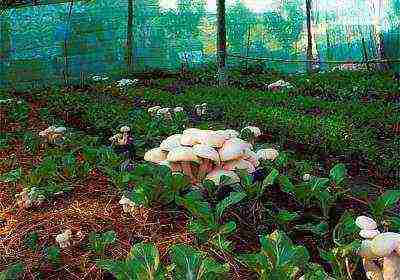 At home
At home
A great way to grow mushrooms at home is to use aerated containers. Such containers were created by the Americans, providing for the possibility of ventilation in them.
You can grow mushrooms using this method even in an apartment on the balcony. It is enough to buy a special container that has a pallet and a lid. These containers are filled with the same compost that we described when growing mushrooms in bags. Before laying the substrate, the container must be disinfected by holding it in an oven at +200 degrees.
The mycelium is sown into the substrate, immersed in 4-5 centimeters, after which the soil is moistened and the container is sent to a warm place. This is an effective and convenient technique. As with bag cultivation, it allows infestation to be localized with ease. However, the method is extremely rarely used by farmers due to the high cost of breeding (considering the industrial scale). But for home use, the method is very good.
For more information on growing mushrooms in a container, see the following video instruction.
For sale (business)
When planning a champignon business, there are two main issues to consider:
- What will be the starting capital?
- What will be the profitability?
Calculating how much money will be needed, decide on the desired volume of cultivation and your goals. Starting by growing mushrooms on the balcony, you need an investment of $ 10 to $ 50. There is no need to count on special income, but the result will be cultivation experience.
Those wishing to organize a large business need to start with a production volume that will yield 50-100 kg of mushrooms per day. This yield can be obtained on an area of about 1000 m².
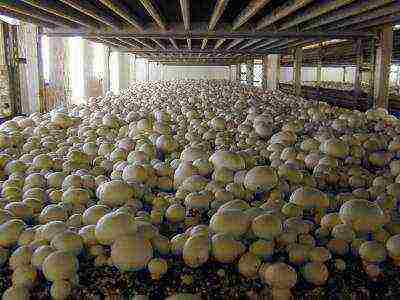
The profitability of mushroom cultivation is noted at the level of 30-50%. It is influenced by growing conditions, production volume, energy consumption and other factors. Direct expenses will be the purchase of mycelium, compost, containers, utilities, workers' salaries and others.
Growing mushrooms in a private household, in dachas and even in apartments is becoming fashionable today. Firstly, in the store, mushroom products are not sold at a low price. Secondly, the homemade mushroom, grown without the use of unknown chemicals, is environmentally friendly and safe for consumption. Thirdly, mushroom growing can be made a profitable business, or at least a good source of additional income. Fourthly, it is a very interesting and exciting hobby. Take a substrate, put mycelium in it, create conditions. And it starts to grow like mushrooms.
Growing champignons at home for beginners
Before you start growing mushrooms
You need to think well and weigh your desire and capabilities on two scales. If they are at about the same level, it is worth the risk. Information for beginners: growing mushrooms at home is a more laborious process than growing oyster mushrooms. But less long-term and more effective than growing porcini mushrooms.
It will take certain costs for the purchase of materials, arrangement of the premises, as well as patience and certain skills. Provided that you already have a suitable room and you only need to create favorable conditions in it.
Premises
It should be moderately cool, such as a cellar or basement.If neither one nor the other is not present, it is difficult to advise anything. Perhaps a garage or greenhouse will do (during the cold season). In spring and early summer, before the onset of extreme heat, mushrooms can be grown without a room at all. The main thing is that the air temperature is not higher than + 20 ° С. Indoors, in the case of year-round cultivation, the temperature should be constantly maintained in the range of + 12 ° С ... 18 ° С, and the humidity should be in the range of 65-85%.
Premises for growing mushrooms
Substrate
The most important item on the list of prerequisites for the successful cultivation of mushrooms is the substrate (or, as it is also called for its composition, compost). The following composition is generally recognized as a fruitful compost option.
- Horse or cow dung (or pork or bird droppings, which can be taken, but not desirable).
- Straw.
- Urea.
- Superphosphate.
- Gypsum.
- A piece of chalk.
- Alabaster flour.
Substrate for growing mushrooms
Table. The proportions of the components for making compost from mullein or horse manure.
Table. The proportions of the components for the composting of poultry manure.
By the way! To cover a one square meter area with mushroom compost, you need compost made from 40 kg of straw base (the rest of the components, according to proportions).
Video - How to disinfect mushroom substrate
How to prepare compost
It is better to carry out this procedure in the air or, in extreme cases, in a regularly ventilated area. As the compost matures in a heap, where the straw is layered with manure and watered with water, the heat can rise to + 70˚C. There is an intensive release of carbon dioxide, water and ammonia vapors into the atmosphere. Of course, a person should not breathe this mixture for a long time.
It is good to place the compost place in the sun (the higher the temperature inside this “puff cake”, the faster and better the compost will ripen). But it is worth providing shelter from rains, since heavy rain can wash out all the useful components necessary for the growth of future mushrooms from the compost.
Compost pit for preparing the substrate
Advice! If it is not possible to protect the compost heap with a canopy from atmospheric precipitation, cover it with roofing material or a thick film before the rain. Be sure to lift the film from the sides, leaving the sides open.
The straw for the substrate must be fresh, dry, free from mold and other defects. Before starting laying, the straw is soaked in a large tank of water for a day. If there is no such reservoir, spread the straw on polyethylene and water it abundantly several times a day, preventing it from drying out.
Laying the compost heap
Straw and manure prepared in this way begin to be laid in layers.
The first layer is straw. Then - manure or droppings.
Each layer of straw is sprinkled with ammonium nitrate, urea in the proportions indicated in the table.
Each layer of straw is watered abundantly with water.
In total, there should be at least 3-4 layers of straw and, accordingly, the same amount of manure.
You need to finish the laying with straw.
Water once again to keep the moisture content of the compost heap constant.
The heap must be at least one meter high. The length and width are arbitrary.
Preparing compost for cultivation
champignons
For a week, the multi-layered structure is basking in the sun. Then comes the moment of the first shaking up. The procedure is carried out with a pitchfork. Shaking up a compost heap is not easy. But they cannot be neglected, since for the speedy composting inside it is necessary to provide oxygen access.
During the first shaking, plaster of Paris is added. It will improve the structure of the compost.
The second shaking is carried out without waiting for the next week, 3-4 days after the first. This time superphosphate and chalk are added.
Important! If the pile is slightly dry in the sun, it is watered abundantly with water. It is impossible to dry out the compost, its formation will stop.
The third and fourth shaking is carried out in four consecutive days. After three weeks, the compost heap will lose its strong ammonia smell and will turn into a pleasant chocolate color. The straw in the compost will become soft and tear with your fingers.
Ready-made compost for growing mushrooms
High-quality compost substrate, completely ready to use, does not stick to the palm, bounces in the fist when squeezed, leaves a wet, but not dirty mark on the skin.
Advice! If you overmoisten the pile, and moisture literally flows out of the compost during compression, it should be decomposed to dry (but not dry, but only reduce the humidity to 60%), adding half the rate of chalk.
The finished substrate is filled in racks, boxes or other containers where mushrooms will be grown. The temperature of the substrate must be lowered before the introduction of the mycelium.
Germination composting process
Preparation of the substrate for further planting of the mycelium
If you plan to grow mushrooms in a room specially designated for this enterprise, for example, on the earthen floor of the cellar, the compost is poured directly onto the floor, in a layer of 70 cm, forming beds with an area of ½ m² or 75x75 cm.
- If in the basement you have equipped racks on which future mushroom crops will grow neatly, they must be equipped with bumpers, and then compost can be placed directly on the racks, with a layer of 45 cm.
- If cultivation is supposed to be in boxes that can be stacked in the same basement or cellar (no more than two meters stack height), because the mushrooms do not need light for development, the compost is poured into boxes. Backfill layer - 25 centimeters
- If you grow mushrooms in an open or greenhouse ground, the compost is rammed directly onto the surface of the ground, 25-30 cm high. The beginning of the laying is early spring, when the ground thaws. Sheds are made over the open ridge to protect from precipitation and sunlight that is too intense for shade-loving champignons.
- The compost is well compacted by hand, the surface is carefully leveled.
Racks for champignons
Mycelium
After the preparatory work, the most important moment comes - planting the mycelium. Mushroom mycelium can be planted at a soil temperature of no higher than + 28 ° C at a depth of 5 cm.Check the temperature with a thermometer. This is important because exceeding even two degrees will kill the mycelium.
The planting material for growing champignons, like other cultivated mushrooms, is a sterile mycelium, which is grown in special laboratories. Champignons for cultivation in culture are selected in two varieties:
- double-sided white;
- double-cornered brown.
Champignon mycelium
There are no significant differences in their taste and nutritional value. The only difference is in the color of the mushroom, according to the name, white or brown. Sell mycelium or mycelium in bags or jars. Packing is usually 1-2 kg. The mycelium of both varieties is grown in two ways - on manure and on cereals.
The first, dung mycelium, will be needed for planting 500 g per m² of area. Grain - not less than 100 g.
Planting mycelium
The dung mycelium is a fairly monolithic lump, which, before planting, must be divided by hand into small pieces, the size of a matchbox half.
- The mycelium prepared in this way is laid out on a large tray in one layer. In the ground, a part of the upper layer is lifted with a wedge-shaped peg so that a piece of mycelium can be laid there.
- Landing is carried out in a checkerboard pattern with a cell distance of 20 cm.
- Part of the mycelium is covered with a substrate, no more than 3 cm thick.
Compost overgrown with mushroom mycelium
Grain mycelium is an ordinary grain on which the spores of the fungus are planted. It is sowed the way you would sow any cereal.
- The top layer of compost, 3 cm wide, is removed from the ridge or box.
- On the surface, "mushroom grains" are randomly scattered.
- The compost is poured back and slightly pressed down so that there is no void between it and the grains.
Grain mushroom mycelium
By the way! Wild mushroom mycelium is also suitable for growing homemade champignons. If you find a place where mushrooms grow, take a closer look at the soil. A land riddled with a web of whitish-gray mushroom spores is a good starting point for your mushroom plantation.
Champignon plantation care
After you have landed, the room temperature is kept high. This is a prerequisite - the germination of mycelium will not begin at below + 24 ° C and above + 26 ° C. At this time, at the initial phase of mycelium growth, do not expect immediate "shoots". Champignons are not vegetables. They grow deeper into the soil, gaining ground and forming the future harvest. At low temperatures, growth is insufficient, at high temperatures - weak formation of the fruiting body.
Rules for harvesting champignons at home
The moisture content of the compost must be constantly maintained in the range of 55-60%. As soon as it dries up, the mycelium "freezes" and stops growing. The compost is moistened superficially, from a sprayer, so that water does not flood the mycelium, otherwise it will become moldy and die
It will take 12 days to grow deep into the mycelium. After that, the temperature in the room will definitely decrease. Either the heating is turned off, or the transoms and ventilation openings are opened - all methods are good to reduce the temperature to + 18 ° С… 20 ° С.
By this time, it is necessary to prepare the soil for backfill. The mycelium will grow upwards not on compost, but from nutrient soil of the following composition:
- sod land;
- loam;
- sandy loam;
- fine-structured peat soil.
Any of the listed structural types will work. The main thing is that the soil is not heavy. To add "airiness" and ensure the penetration of air to the spores of the fungus, the soil is sieved on a coarse sieve.
Agricultural practices and terms of their implementation when growing mushrooms
Before backfilling, the soil is moderately moistened. And cover them with a layer of compost 3-4 cm.
Further, caring for the mushrooms is simple.
Maintaining the temperature within the specified limits. - + 16 ° С… 18 ° С, plus or minus two more permissible degrees.
Maintaining humidity in the range of 65-85% (air) and not higher than 60% - of the earth layer.
Daily intensive ventilation of the room to remove accumulated carbon dioxide.
You can collect the first homemade mushrooms from your own plantation as early as 35-40 days. One fruiting cycle lasts about two months.
Agricultural practices and terms of their implementation when growing mushrooms (continued)
Despite all the seeming difficulties and conventions, the cultivation process, starting from the moment the compost is prepared, takes no more than four months. For two months of fruiting, the crop can be harvested 6-7 times. From a meter of a square ridge, 5 to 10 kg of mushrooms are harvested. The next crop ripens after 5 days.
Harvesting champignons
Important! Mushrooms must be collected at a stage when the film between the stem and the cap is not damaged and connects them tightly. Opened mushrooms with darkened (for white varieties) plates and a damaged film, the remnants of which can only be seen on the stem, it is better not to eat
The champignons are not cut with a knife during collection. The mushrooms are twisted with a gentle movement of the hand. The holes formed after collection are sprinkled with soil and slightly moistened.
Video - Growing champignons at home (part 1)
Video - Growing champignons at home (part 2)
Video - Harvesting champignons


